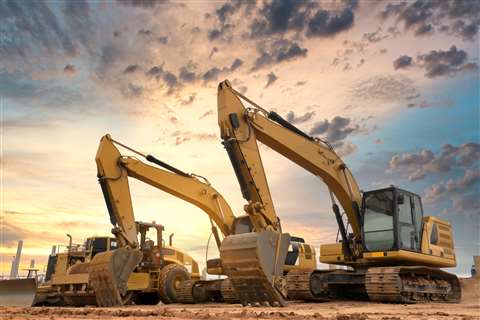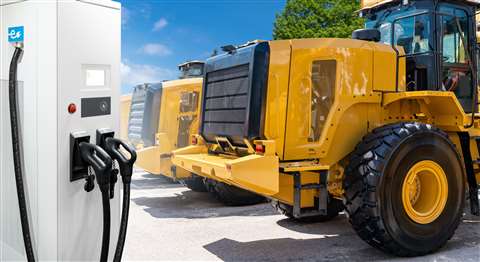Five construction equipment trends for 2023
13 February 2023
 More and more construction equipment is being sold online
More and more construction equipment is being sold online
The Association of Equipment Manufacturers (AEM), a North American-based trade association and the organisers of ConExpo have spoken to industry experts who have highlighted five equipment trends that will shape 2023.
Increasing importance of online sales and online rentals
In 2021 online sales of automobiles reached 30% of the market, their highest level. In July 2022, Ford announced it would move sales of its electric vehicles online at a fixed price, following Volvo and Tesla. “Whatever happens in the auto industry, is coming to construction equipment dealerships,” says Garry Bartecki, CFO of a Top 100 rental company and former CFO of the Associated Equipment Distributors (AED).
In a 2021 study from McKinsey & Company, sponsored by AED, more than 40% of off-highway dealers surveyed think it is very likely or somewhat likely that the OEM(s) they represent will implement a direct-to-consumer model within five years. They expect fully digital sales (including the actual purchase) for new equipment to increase from 7% to 29% and digital rentals to increase from 7% to 33% within five years.
“We definitely see things moving in this direction,” says Jefferson Yin, Director of New Business Models and Commercial Intelligence at Volvo Construction Equipment. In 2020, the company began allowing customers to pre-order new electric equipment online, and they recently launched an online configuration tool for those machines, which allows customers to “build and price” their ideal model.
“There will still be transportation, delivery, and service, but it will be much more efficient,” explains Steve Clegg, Managing Director and Owner of Winsby, Inc., a business development firm with clients in the construction equipment industry.
“Dealers are behind the curve and contractors are ahead of the curve when it comes to utilizing the Internet,” says Ron Slee, Managing Director Learning Without Scars, a training resource for dealers. The shift to e-commerce creates what he calls “the Amazon effect,” which means dealers will have to transition from selling things to selling services.
Electrification will disrupt the dealer’s revenue model
Electrification of construction equipment is in its early stages, but Grand View Research reports that the global off-highway electric vehicle market size is expected to reach US$42 billion by 2030. Growth will be driven by lower operating costs as well as improved battery technology and lower costs for batteries. “You are going to see the whole industry switch to battery-operated or hybrid machines,” says Clegg. “The amount of parts drops by about 90%, so if your operating costs for a skid-steer were $20 an hour, that drops to $3 per hour.”
 Electric construction equipment will disrupt the industry in numerous ways
Electric construction equipment will disrupt the industry in numerous ways
Dealers make their money on parts and services, and a high absorption rate (+85%) is a key focus. This metric is an indication of how well the margin from parts and services covers all the expenses of the dealership.
“Electric machines will cut the maintenance costs, so the dealers will make less money and the OEMS will make less money,” says Bartecki. “It’s a whole new ball game.”
To make up for the difference, dealerships will have to focus on new revenue sources. “Because they have the service expertise, I would recommend they move into supporting and servicing batteries, providing services such as recharging vehicles, tires, wear parts, and repair,” says Clegg. “They can also expand into different lines of equipment.”
Connected machines and jobsites to cut owning and operating costs
Nearly all new construction equipment machinery is equipped with technology that allows equipment owners and dealers to avoid downtime through preventative maintenance and early detection of mechanical issues. The challenge has been getting equipment owners on board. “Across the industry, adoption of telematics is definitely under 50%, and maybe only 30%,” says Henderson.
“The dealer has the trust of their customer, but they tend to be a single brand, while most customers have mixed fleets,” says Hanna.
Slee believes OEMs have tried to protect their own at the expense of the marketplace, but he’s starting to see some signs of change. “The machines need to be able to talk to each other as they do in other industries,” says Slee.
According to Jim Bretz, Director of Service and Solutions for Volvo CE, about 60% of Volvo’s connected machines use the company’s advanced telematics system, ActiveCare Direct. These machines are monitored 24/7/365 for alarms that indicate an issue. Actionable information (an ACD case) is then sent directly to the customer’s equipment manager and the local dealer within minutes. Included is information that will help the customer address the issue without the help of a dealer.
Technology will bring greater efficiency to parts and service
Parts are the bread and butter of a dealership, but for an end-user, buying parts is anything but easy. When a machine is down, the costs are astounding and end-users and rental dealers are likely to pay a premium to get a quality part as quickly as possible. Buyers often need guidance; that may mean multiple phone calls and texts from multiple sources, including OEM and aftermarket parts dealers. Each part of the distribution chain has its own distribution, logistics, and markup.
According to Slee, OEM dealer market share for parts has dropped to 35-40%, about half of what it once was. Buyers today simply have more options, including Amazon.
 Construction technology leads to increased productivity, if used correctly
Construction technology leads to increased productivity, if used correctly
Luke Powers, CEO of Gearflow, a web-based platform, believes dealers will soon be competing directly with Amazon. “MRO supplies are the first entry point of Amazon coming into the industrial markets,” says Powers. “Amazon wants all procurement to be done on its platform regardless of the industry. Private-label brands in the construction equipment industry are the logical next step after adding MRO to their selection.”
Rental continues to grow
Rental is expected to continue its upward trajectory fueled by higher prices for construction machinery and rising interest rates. According to the America Rental Association, construction equipment rental revenue is expected to increase 12.5% in 2022 to surpass US$41.6 billion.
The concept of equipment-as-a-service, which would transfer responsibility for equipment to the manufacturer or dealer, allowing customers to focus on their core business, is also gaining interest. Unlike equipment rental, it might involve an entire fleet to be provided for several years with the potential to tie invoicing directly to usage.
Slee believes the concept has potential. “Contractors use the machine to dig a hole. They are only interested in the hole, and they look at the equipment merely as an operating cost,” he says.
Volvo CE is currently exploring the concept. “One of the most positive aspects from a customer perspective is the payment flexibility that this model offers since it’s usually linked to machine utilization,” says Dr. Ray Gallant, Vice President of Product Management and Productivity for Volvo CE.
“It’s a very customised offer and it requires that the OEM, dealer, and customer are aligned so the fleet performs accordingly and delivers the expected results.”
STAY CONNECTED



Receive the information you need when you need it through our world-leading magazines, newsletters and daily briefings.
CONNECT WITH THE TEAM








